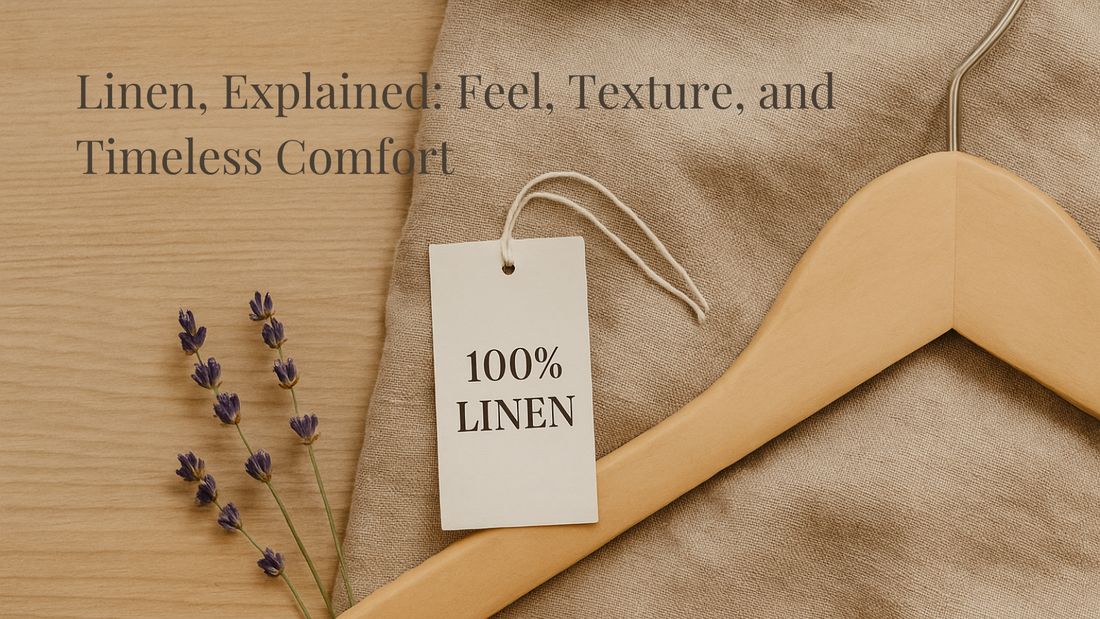
How Does Linen Fabric Feel? Everything You Need to Know Before You Wear It
How Does Linen Fabric Feel?
In our previous posts, we’ve talked a lot about linen care - how to keep it fresh between washes, how to embrace its natural wrinkles, and why less is often more when it comes to laundering.
But one thing we haven’t explored in detail is the fabric itself.
What does linen actually feel like when you wear it?
How does it compare to cotton or other natural materials?
And why do some people fall in love with its texture from the very first touch?
In this article, we’ll go beyond care tips and dive into what makes linen feel so unique - from how it’s made, to the different types of linen, and why it’s one of the most beloved fabrics in timeless wardrobes.

The Texture and Feel of Linen
Linen has a very distinct feel - dry, crisp, and structured at first touch. But don’t let that fool you. The more you wear and wash it, the softer and more relaxed it becomes, without losing its shape.
It’s naturally breathable and cool on the skin, which is why it’s so perfect for warm weather or layering through changing seasons. Since linen doesn’t stretch, it holds its form and moves with your body without clinging.
Its surface can feel slightly textured or “nubby” – that’s a sign of authenticity, not a flaw. It’s part of what gives linen its effortless, lived-in charm.
🧵 Did you know? Linen is one of the oldest fabrics in the world. Ancient Egyptians used it for everything from clothing to wrapping mummies – because it was strong, pure, and long-lasting. Thousands of years later, we still choose linen for many of the same reasons: it’s durable, breathable, and beautifully timeless.
Types of Linen Fabrics (and How They Differ)
Not all linen feels the same and a lot depends on how it’s made and what it’s blended with.
🧵 How is linen made?
Linen comes from the flax plant. Its fibers are extracted from the stalks through a slow, traditional process called retting, then spun into yarn and woven into fabric. This natural method is what gives linen its signature texture and strength.
Here are the most common types you’ll come across:
- Pure linen
Made entirely from flax fibers, pure linen is the most breathable and has that classic crisp texture. It wrinkles more easily - but that’s part of the charm.
- Linen-cotton blend
Blended with cotton for extra softness and fewer wrinkles. Still breathable, but with a smoother feel and easier care. LeMuse often uses this blend for a balance between structure and comfort.
- Washed or softened linen
This linen is pre-washed (often with natural enzymes or stonewashed) to make it feel softer from day one. It has a more relaxed look and slightly worn-in feel.
- Lightweight vs. heavyweight linen
Lightweight linen is airy and ideal for summer dresses or layering pieces. Heavier linen is often used for tailored pieces or cooler seasons - it holds shape better and has a more structured drape.
Linen vs Cotton: What’s the Difference in Feel?

💡 If you like structure and breathability, go for linen. If you love soft and cozy, cotton might be your match. Or choose a blend for balance.
What Is Linen Fabric Used For?
Linen is one of the most versatile natural fabrics out there. You’ll find it everywhere - from your wardrobe to your home.
In fashion, it’s loved for summer dresses, shirts, skirts, and trousers. It keeps you cool in the heat, looks effortlessly elegant, and feels light on the skin.
At home, linen shines in bedding - think crisp sheets and breathable pillowcases that stay cool through the night. It’s also a favorite for tablecloths, napkins, and other home textiles thanks to its clean look and timeless texture.
At LeMuse, we choose linen not just for how it looks, but for how it feels. It brings together elegance, ease, and longevity - qualities we want in every piece we create. Linen wears beautifully, softens with time, and always feels like a natural choice.
Final Thoughts
Linen isn’t just a fabric - it’s a feeling. It’s the quiet comfort of something breathable on your skin, the subtle elegance of natural texture, and the lived-in softness that gets better with time.
We’ve talked a lot about how to care for linen and how to reduce wrinkles - but at the heart of it all is this: linen is meant to be worn, not perfected.
Explore our linen collection and feel the difference for yourself → dresslemuse.com
